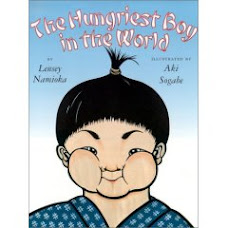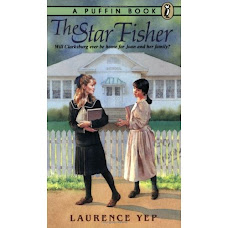BIBLIOGRAPHY
Namioka, Lensey. 2001. The Hungriest Boy in the World. Illustrator, Aki Sogabe. Holiday House; 1st ed edition ISBN-10: 0823415422 ISBN-13: 978-0823415427
SUMMARY
A young Japanese boy named Jiro has a habit of putting everything in his mouth. He picks up a purple slimy blob and pops it in his mouth. Jiro has a hunger monster slide down his throat and now he can't get enough to eat. His sister is very observant and notices the unusual occurrences. He eats a bucket of fish guts and part of a fishing net. He even eats his blanket in his sleep. His family calls in the doctor for help but Jiro ate all the doctors' medicine. Next his father took him to the priest but he ate the priest's string of beads. The medium is called in and tells the family about the Hunger Monster. A puppeteer is called to help with the problem. The family prepares a feast that they put out for the puppet. The Hunger Monster can't resist the food and jumps into the mouth of the puppet. It falls to the floor were it is swept out the door.
CRITICAL REVIEW
The Hungriest Boy in the World is a story published in 2001 that appears to be an old time folktale. It tells the story of excess and gluttony in a humorous tale. It is an entertaining story that will be enjoyed by children.
The characters in the story wear traditional clothing and eat Japanese foods of rice balls and fish. In the story the father and his sons eat first with mother and sister eating last. The family sits on cushions on the floor at a low table. The beds are pallets on the floor with head cushions. Silk screen walls are another item that represents the Japanese culture. Jiro's family are fisherman, an occupation that is stereotypical of a Japanese family. The author is Chinese but has been married to a Japanese man for many years. The doctor visits Jiro and uses the traditional Eastern medicine technique of diagnosing with the pulse. The book is timeless. It can't be determined if the customs and traditions in the book are current for today or a hundred years ago.
Sogabes' is a Japanese artist that has lived in Seattle Washington since 1978. The illustrations are in a traditional Japanese paper cut technique with watercolor and airbrush added for color. The heavy black line is the cut paper with rice paper as a background.
REVIEWS
From Publishers Weekly
Namioka (The Laziest Boy in the World) pens another amusing original tale, this one set in Japan. Jiro's bad habit of putting everything in his mouth causes him to swallow the Hunger Monster. Suddenly the boy is ravenous, indiscriminately wolfing down everything from sushi to fishing nets ("They looked like noodles, delicious noodles, seasoned with soy sauce"), his quilt, a floor cushion--whatever comes within his reach. When a doctor is called, Jiro gobbles down all his medicines. When a medium is consulted, Jiro tries to eat her hair--though not before she fingers the Hunger Monster as the culprit. Finally, Jiro's brother suggests they call in a puppet master, who tricks the creature into leaving Jiro's stomach. Namioka's light, comic touch extends to her jaunty pacing, setting a tone that Sogabe (The Loyal Cat) extends with her stylish cut-paper, watercolor and airbrush illustrations. Set in an old-world Japan complete with kimonos and forest temples, and peopled with chunky, heavily outlined figures, her airy compositions underscore the folktale aura, while the impossibly fat-cheeked Jiro steals every scene. Ages 4-8.
Copyright 2001 Cahners Business Information, Inc.
From School Library Journal
K-Gr 3-Jiro, a Japanese boy, has a bad habit. He puts everything in his mouth, be it seashells, seaweed, or sushi. When the child accidentally swallows the Hunger Monster, his troubles and readers' fun begin. Jiro's appetite runs rampant, and he consumes everything from fish guts and netting to his own bed quilt. His parents frantically seek assistance from the doctor, the village priest, and a medium, as Jiro snacks on the doctor's medicines, the priest's prayer beads, and the medium's hair. The situation eventually reaches a clever and happy solution. The story is told economically but with wit and humor. Sogabe's illustrations, created using cut paper over rice paper that has been colored by airbrush or watercolor, complement the text with their elegant simplicity. Pair this tale with Jim Aylesworth's The Full Belly Bowl (Atheneum, 1999) for a discussion of the hazards of excess, incorporate it into multicultural units, or enjoy it for sheer fun.-Grace Oliff, Ann Blanche Smith School, Hillsdale, NJ
Copyright 2001 Cahners Business Information, Inc.
CONNECTIONS
Other books by Lensey Namioka
Ties That Bind, Ties That Break. 2003. Puffin Books; New Ed edition. ISBN-10: 0141317159 ISBN-13: 978-0141317151
Half and Half Yearling. 2004. ISBN-10: 0440418909 ISBN-13: 978-0440418900
An Ocean Apart, a World Away Laurel Leaf. 2003. ISBN-10: 0440229731 ISBN-13: 978-0440229735
Subscribe to:
Post Comments (Atom)







No comments:
Post a Comment